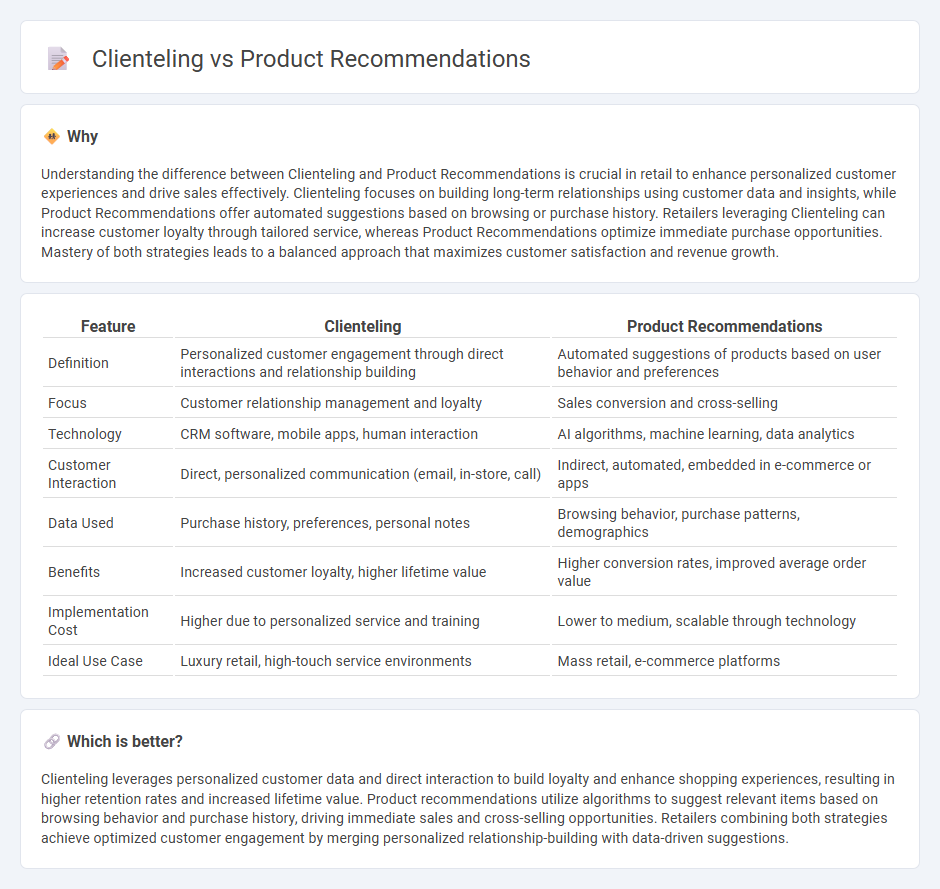
Clienteling enhances retail by leveraging personalized customer profiles to deliver tailored shopping experiences, increasing loyalty and repeat purchases. Product recommendations utilize AI algorithms to analyze browsing and purchase history, offering relevant suggestions that boost sales and improve user satisfaction. Explore the distinctions and benefits of clienteling versus product recommendations to optimize your retail strategy.
Why it is important
Understanding the difference between Clienteling and Product Recommendations is crucial in retail to enhance personalized customer experiences and drive sales effectively. Clienteling focuses on building long-term relationships using customer data and insights, while Product Recommendations offer automated suggestions based on browsing or purchase history. Retailers leveraging Clienteling can increase customer loyalty through tailored service, whereas Product Recommendations optimize immediate purchase opportunities. Mastery of both strategies leads to a balanced approach that maximizes customer satisfaction and revenue growth.
Comparison Table
| Feature | Clienteling | Product Recommendations |
|---|---|---|
| Definition | Personalized customer engagement through direct interactions and relationship building | Automated suggestions of products based on user behavior and preferences |
| Focus | Customer relationship management and loyalty | Sales conversion and cross-selling |
| Technology | CRM software, mobile apps, human interaction | AI algorithms, machine learning, data analytics |
| Customer Interaction | Direct, personalized communication (email, in-store, call) | Indirect, automated, embedded in e-commerce or apps |
| Data Used | Purchase history, preferences, personal notes | Browsing behavior, purchase patterns, demographics |
| Benefits | Increased customer loyalty, higher lifetime value | Higher conversion rates, improved average order value |
| Implementation Cost | Higher due to personalized service and training | Lower to medium, scalable through technology |
| Ideal Use Case | Luxury retail, high-touch service environments | Mass retail, e-commerce platforms |
Which is better?
Clienteling leverages personalized customer data and direct interaction to build loyalty and enhance shopping experiences, resulting in higher retention rates and increased lifetime value. Product recommendations utilize algorithms to suggest relevant items based on browsing behavior and purchase history, driving immediate sales and cross-selling opportunities. Retailers combining both strategies achieve optimized customer engagement by merging personalized relationship-building with data-driven suggestions.
Connection
Clienteling leverages customer data and purchase history to deliver personalized product recommendations that enhance the shopping experience and boost loyalty. Retailers use algorithms and AI-driven insights to tailor suggestions based on individual preferences, increasing conversion rates and average order value. This data-driven approach strengthens customer relationships by providing relevant, timely product options that meet specific needs.
Key Terms
Personalization
Product recommendations leverage algorithms and data analytics to suggest items based on browsing history, past purchases, and user preferences, enhancing the e-commerce experience. Clienteling involves personalized interactions by sales associates using customer data to build deeper relationships, improve customer loyalty, and increase repeat purchases. Explore how integrating both strategies can maximize personalization and drive sales growth.
Cross-selling
Product recommendations utilize data algorithms and customer behavior analytics to suggest relevant items, enhancing cross-selling opportunities by presenting complementary products. Clienteling emphasizes personalized, relationship-driven interactions where sales associates use customer profiles and purchase history to offer tailored recommendations, fostering stronger customer loyalty. Discover how integrating both strategies can maximize cross-selling effectiveness and boost overall sales.
Customer Relationship Management (CRM)
Product recommendations leverage data algorithms to suggest items based on customer behavior, enhancing personalized shopping experiences within CRM. Clienteling emphasizes building deeper, one-on-one relationships by using CRM tools to track preferences, purchase history, and interactions, fostering loyalty and repeat business. Explore how integrating both strategies can maximize customer engagement and boost revenue.
Source and External Links
11 Remarkable Product Recommendation Examples - Wiser Notify - This guide details various product recommendation tools like Nosto and Barilliance, explaining how they use AI and customer behavior to provide relevant, personalized suggestions while highlighting common mistakes such as ignoring customer preferences in recommendations.
Product Recommendations for WooCommerce - A state-of-the-art WooCommerce platform blending human intelligence and machine learning to generate automated, context-aware upsell and cross-sell product recommendations, enabling merchants to increase sales easily by adding recommendations in bulk with category and attribute filters.
What are product recommendations? - Optimizely - Explains ecommerce strategies for product recommendations across various store pages (homepage, product, category, cart, post-purchase), focusing on personalized, trending, complementary, and upselling suggestions tailored to shopper behavior and purchase patterns.
 dowidth.com
dowidth.com